

CHAPTER II.
UNITY
Introduction-
Mental and Material Considerations Connected with Each of the Methods-
Yet divisible in a General way into those Manifesting Effects of Mind, of Nature, and of both Combined-
How Mental Considerations lead to Unity-
This attained by putting the like with the like by Way of comparison-
Exemplified in the Art-forms: in Poetry-
in Music-in Paintings-in statues-
in buildings of all styles-
in Natural Forms-
This Method Necessary to imaginative or any aesthetic expression-
How the consideration of Natural Forms leads to variety-
This involves putting the like with the unlike by way of contrast; its effects illustrated in classification-
Variety in Poetry-
In Music-
In Painting, Sculpture, and Architecture-
Direct Antithesis as related to comparison-
Its Effects in Literature-
in Poetry-In Music-in Outline-in Color-
How considerations of mind and nature, or unity and variety, lead to complexity-
How comparison and Contrast Leads to Complement.
WE are now prepared to consider in a general way, which only is necessary for our purpose, certain facts with reference to the methods pursued by men when forming the groups brought together in classification. For the reasons given in the last chapter, we may expect, as a result, to obtain important suggestions with reference to the right methods of bringing together factors in art-forms.
Let us start here, recognizing again the intimate connection always existing in art between expression and
[The Genesis of Art-Form by G.L. Raymond, chapter II, page 013]
form, by stating anew the fact already brought out in the last chapter, namely, that the artist in his work is influenced by both mental and material considerations. He begins with a conception which in his mind is associated with certain forms or series of forms, and to these he adds others, expressive of a similar conception. These latter, it is evident, are attributable, some of them to the character of the conception that he wishes to express, and some of them to the character of the natural forms through which he must express it; some of them, in other words, to mental, and some of them to material considerations. But while this is true in such a sense as to justify a general division of his methods upon the ground that they are traceable in part to the character of mind and in part to that of nature, there is also a sense in which every one of them is traceable to both. For this reason a discussion of any method whatever must include, to be complete, some reference both to its mental and to its material hearings.
With this explanation, which will show that it is not intended to make too exclusive a statement in any case, we may divide the methods of classification and also of art-composition into those that manifest chiefly the effects of mind, of nature, and of the combined influences of both.
So far as classification results from the conditions of mind, its function is to simplify the work of forming concepts, and its end is attained in the degree in which it enables one to conceive of many different things-bird or beasts, larks or geese, dogs or sheep, as the case may be-as one. Classification is, therefore, an effort in the direction of unity. It is hardly necessary to add that the same is true of art-composition. Its object is to unite many different features in a single form, an effect invariably pro[duced]
[The Genesis of Art-Form by G.L. Raymond, chapter II, page 014]
[pro]duced, too, by all except the most elementary products of nature.
Unity being the aim of classification, it is evident that the most natural way of attaining this aim, is that which was mentioned in the first chapter, namely, putting like with like; and that doing this necessitates a process of comparison. It is because all fish are seen in some way to compare, that the mind classes them in one group, and is enabled ever after to conceive of this group as a unity. 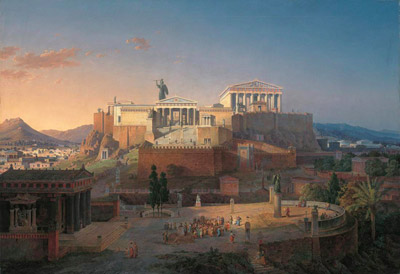 [click here to enlarge image]
[click here to enlarge image]
Fig. 1 – Restoration of the
(See pages 16, 75, 89, 123, 207, 261)
Turning now to the aesthetic arts, and considering how what we term form in them has been developed, we shall have no difficulty in recognizing it to be the result of an application of a similar method. To show this, were we to follow the order most naturally suggested by that of their historic and psychologic development, we should begin with music; but as poetry is more susceptible of
[The Genesis of Art-Form by G.L. Raymond, chapter II, page 015]
exemplification in book form, it will be better for our purposes in the present discussion to begin all our illustrations with it. Looking first at poetry, then, we find the chief characteristic of its form to be lines of like lengths, divided into like numbers of feet, each uttered in like time, to which are sometimes added alliteration, assonance, and rhyme, produced by the recurrence of like sounds in either consonants, vowels, or both.
So with music. The chief characteristic of its form is a series of phrases of like lengths, divided into like numbers of measures, all sounded in like time, through the use of notes that move upward or downward in the scale at like intervals, with like recurrences of melody and harmony.
In painting, sculpture, and architecture, no matter of what “style” the same is true. The most superficial inspection of any product of these arts, if it be of established reputation, will convince one that it is composed in the main by putting together forms that are alike in such things as color, shape, size, posture, and proportion. In confirmation of this, observe, of paintings, Rubens’ “Descent from the Cross,” Fig. 16, page 73; Gerome's –“Pollice Verso,” Fig. 26, page 81; Tenier's “Village Dance,” Fig. 43, page 143 ; Troyon's “Cattle,” Fig. 50, page 173; Turner's “Decline of Carthage,” Fig. 51, page 175 ; and Correggio's “Holy Night,” Fig. 70, page 225. Read also pages 255-6.
Of statues, observe a part of the “Group of the Niobe,” Fig. 45, page 146; “The Soldier's Return,” from the
Finally, of buildings, observe, in the Greek style, the “
[The Genesis of Art-Form by G.L. Raymond, chapter II, page 016]
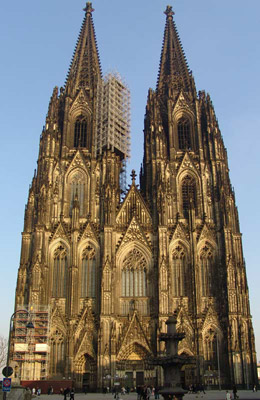 [click here to enlarge image]
[click here to enlarge image]
Fig. 2 –
(See pages 18, 87, 90, 190, 207, 291)
photo credit: Christoph Rückert (Wikipedia)
[The Genesis of Art-Form by G.L. Raymond, chapter II, page 017]
Greco-Roman style, “St. Peter's, Rome,” Fig. 23, page 78; in the Gothic style, the “Cathedral of Cologne,” Fig. 2, page 17, of “Salisbury,” Fig. 68, page 207, and of “Canterbury,” Fig. 32, page 89; in the Romanesque or Norman style, the “Cathedral of Sienna,” Fig. 97 page 292, and the “Interior of the Church of the Sacred Heart, Paris,” Fig. 12, page 49; and, in the Byzantine and Oriental styles, “St. Mark's, Venice,” Fig. 31, page 88, the “Mosque of St. Sophia,'“ Fig. 42, page 123, the Chinese Temple, Fig. 69, page 208, and that great memorial structure of India, by many considered the most beautiful building in the world, the “Taj Mahal,” Fig. 3, page 19.
Notice now, as was intimated in the last chapter, that art, in pursuing this method, does no more than to carry farther a process that nature itself has already begun. The utterance of every bird or beast is made up of notes sufficiently similar to be termed, in a broad sense, alike. Every tree is covered with like limbs and leaves, every animal with like hair or scales or feathers, and every pair of feet or hands is ended with like claws or toes or fingers.
Notice, again, that the method involves no more than is necessary in order to make the products of art what they are. Every one knows that comparison is the very first result of any exercise of the imagination. And he knows also that imagination is the source of all art-production. When a man begins to find in one feature the image of another, and, because the two are alike, to put them together by way of comparison, then, and then only, does he begin to construct an art-product. And not only so, but only then does he continue his work in a way to make it continue to be a medium of expression. The forms which he elaborates are naturally representative of certain phases of thought or feeling, and the significance
[The Genesis of Art-Form by G.L. Raymond, chapter II, page 018]
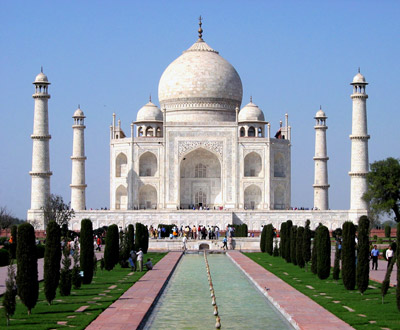 [click here to enlarge image]
[click here to enlarge image]
Fig. 3 – Taj
photo credit: Dhirad (Wikimedia Commons)
[The Genesis of Art-Form by G.L. Raymond, chapter II, page 019]
of the completed product depends upon its continuing to represent these phases. But it can continue to do this only when that which is added in the process of elaboration is essentially like that with which the process starts. It is a striking illustration of the rationality which characterizes the action of the mind when working naturally and instinctively though without knowledge of reasons, that the forms of all the arts, as developed in primitive ages, should fulfil this rational requirement. It is an equally striking illustration of the irrationality and departure from nature into which too much self-conscious ratiocination may plunge the same mind, that, in our own more enlightened age, art-forms should not only be tolerated but praised-in poems and buildings for instance-in which the principle of putting like with like has been utterly disregarded. Observe the style of the following:
Who learns my lesson complete?
Boss, journeyman, apprentice-churchman and atheist,
The stupid and the wise thinker-parent and offspring, merchant, clerk,
porter and customer,
Editor, author, artist and schoolboy-Draw nigh and commence;
It is no lesson-it lets down the bars to a good lesson,
And then to another, and every one to another still.
-Leaves of Grass: Whitman
O I believe there is nothing real but
O to sternly reject all except democracy!
O imperator ! O who dare confront you and me!
O to promulgate our own! O to build for that which builds for mankind.
O feuillage! O North! O the slope drained by the Mexican sea!
O all, all inseparable-ages, ages, ages!
-Idem.
Observe also the utter absence of any attempt to fulfil this first requirement of art, in the buildings represented
[The Genesis of Art-Form by G.L. Raymond, chapter II, page 020]
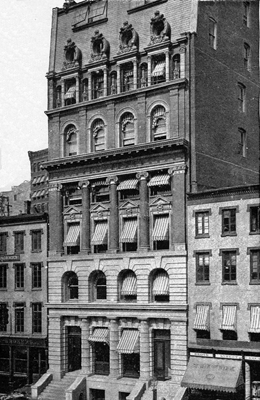 [click here to enlarge image]
[click here to enlarge image]
Fig. 4 – The
[The Genesis of Art-Form by G.L. Raymond, chapter II, page 021]
in Fig. 4, page 21, Fig. 5, page 23 ; also in Fig. 60, page 191, and Fig. 67, page 205.
But classification is traceable not only to the conditions of mind but also of nature. It is in the latter that the mind is confronted with that which classification is intended to overcome, with that which is the opposite of unity-namely, variety. If there were none of this in nature, all things would appear to be alike, and classification would be unnecessary. As a fact, however, no two things are alike in all regards; and the mind must content itself with putting together those that are alike in some regards.
This is the same as to say that classification involves, secondarily, the principle of putting the like with the unlike; and necessitates contrast as well as comparison. The objects brought together in the same group, while similar in certain general and salient features, are dissimilar in particular and less prominent ones. From a distance, or upon first observation, all the voices of men and all the trees of a forest may seem like repetitions of each other. Were it not so, we should fail to understand what is meant by the terms “human voice” and “oak-tree.” We use these terms as a result of unconscious classification obtained by regarding certain general features that first attract attention. But when we approach near the object or examine it carefully, we find that each voice and tree differs from its neighbors; not only so, but each note of the same voice and each leaf of the same tree.
A similar fact is observable in products of art. They, too, while developed from the tendency to group together forms that are alike, are composed of factors not alike in all regards. Take poetry. Who does not perceive the
[The Genesis of Art-Form by G.L. Raymond, chapter II, page 022]
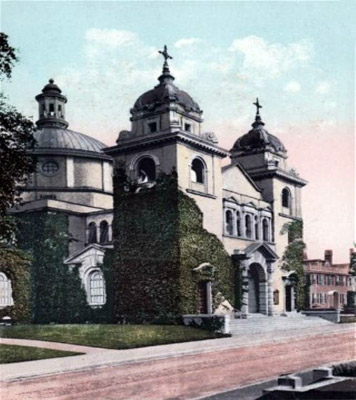 [click here to enlarge image]
[click here to enlarge image]
Fig. 5 – Central Congregational Church,
photo credit: unkown
[The Genesis of Art-Form by G.L. Raymond, chapter II, page 023]
additional charm imparted to verses in which more or less unlikeness is blended with that likeness, which, a moment ago, was said to constitute the chief element of their forms? What is it that imparts freedom and naturalness to the sounds of the following lines, except the introduction, here and there, of changes which, nevertheless, do not interfere with the general similarity of effect characterizing the whole?
That orbed maiden with white fire laden
Whom mortals call the moon,
Glides glimmering o'er my fleece-like floor
By the midnight breezes strewn;
And wherever the beat of her unseen feet,
Which only the angels hear
May have broken the woof of my tents thin roof,
The stars peep behind her and peer;
And I laugh to see them whirl and flee,
Like a swarm of golden bees,
While I widen the rent of my wind-built tent,
Till the calm rivers, lakes, and seas,
Like strips of the sky fallen through on high,
Are each paved with the moon and these.
-The Cloud: Shelley.
They passed the hall that echoes still,
Pass as lightly as you will.
The brands are flat, the brands are dying,
Amid their own white ashes lying;
But when the lady passed there came
A tongue of light, a flit of flame,
And Cristabel saw the lady's eye,
And nothing else saw she thereby,
Save the boss on the shield of Sir Leoline tall,
Which hung in a murky old niche in the wall,
“O softly tread,” said,
“My father seldom sleepeth well.”
-Cristabel: Coleridge.
[The Genesis of Art-Form by G.L. Raymond, chapter II, page 024]
As contrasted with these, any one can recognize that the following, on account-among other things-of its lack of variety, is less satisfactory.
Think, Daphnis, think, what tender things you said;
Think what confusion all my soul betrayed,
You called my graceful presence Cynthia's air,
And when I sung, the syrens charmed your ear;
My flame, blown up by flattery, stronger grew,
A gale of love in every whisper flew.
Ah! faithless youth, two well you saw my pain,
For eyes the language of the soul explain.
-Araminta: Gay.
Take music too. Compare the subtle modifications characterizing successive phrases in even a simple melody of Mozart, like the first of the following examples, with the monotonous cadences of an ordinary street song, such as is represented in the second.
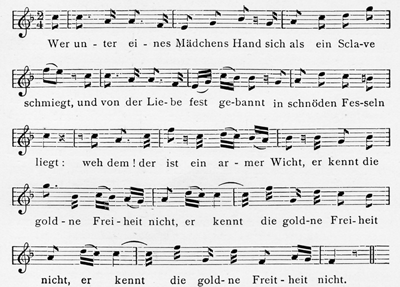
-Lied der Freiheit
by Mozart
[click here to enlarge image or click here to play music sample]
[The Genesis of Art-Form by G.L. Raymond, chapter II, page 025]
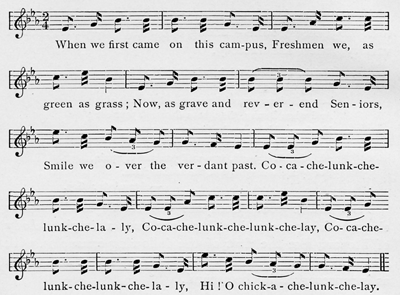
-Co-ca-che-lunk: College Song
by unknown
[click here to enlarge image or click here to play music sample]
A similar truth is illustrated in painting and sculpture. As will be shown by and by, the most important essential of excellence in the forms of these arts is caused by effects resulting from innumerable repetitions and correspondences; yet, perhaps, the most invariable characteristic of inartistic pictures and statues is a lack of sufficient diversity, colors too similar, outlines too uniform. See Fig. 6, page 27; and contrast it with the more artistic management of similar effects in “The Soldier’s Return,” Fig. 52, page 176. So, too, with architecture. Notice the conventional fronts of the buildings on many of the streets of our cities. Their accumulations of doors and windows and cornices, all of like sizes and shapes, are certainly not in the highest sense interesting. For this their outlines are too little varied. 1 When we have seen a few of them, we have seen all of them. But, in order to continue to
1Yet often too greatly, as by ten stories next door to only two.
[The Genesis of Art-Form by G.L. Raymond, chapter II, page 026]
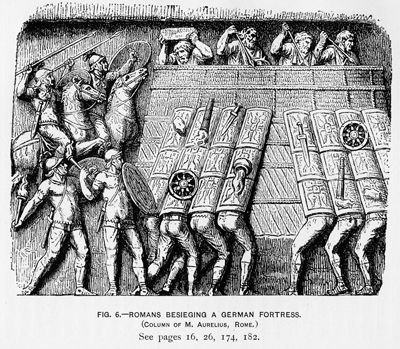 [click here to enlarge image]
[click here to enlarge image]
Fig. 6 – Romans Besieging A German Fortress (Column of M. Aurelius,
(See pages 16, 26, 174, 182)
[The Genesis of Art-Form by G.L. Raymond, chapter II, page 027]
interest the mind, forms must continue to present to it something that has not been seen before. All these facts show that even though an art-product is constructed, in the main, upon the principle of putting like with like, a lack of likeness is sometimes desirable in order to introduce into the form that element of change 1 which in poetry and music is necessary to the effect of movement, and in painting, sculpture, and architecture, to the effect of life, which is closely allied to that of movement.
It is important now to notice further that if occasional unlikeness is to be introduced into a form, the more apparent the unlikeness is, the more satisfactory often is its effect. In this case the dissimilarity attracts more attention both to itself and to the general method of comparison which it opposes. No form appears to be so individual in character as when it is thrown into relief by the proximity of other forms between which and itself the difference is radical; as the figure of a man, for instance, when surrounded by natural scenery; or as a smooth young face when surmounted by the gray hair of a wig. In addition to this, it is worth remarking that in the degree in which unlike features are the most distinctly antithetic they show the clearest possible consciousness on the part of the artist that comparison is the main process employed, and that variety is exceptional. No one can originate or recognize an antithesis-by which is meant an effect produced when two objects differ diametrically in at least one particular, and yet agree in others-except as a result of comparison. For all these reasons contrast, when used within proper limits, is a legitimate artistic method.
In literature, for instance, every well-written page is full of contrasts expressed, either directly, as in “Open rebuke is better than secret love,” “Gold cannot make a man
1Compare with this what is said on pages 139, 189, and 258.
[The Genesis of Art-Form by G.L. Raymond, chapter II, page 028]
happy any more than rags can render him miserable”; or else indirectly, as in Lord Chatham's question, when opposing the war against the American colonies: “Who is the man that has dared to call into civilized alliance the wild and inhuman inhabitant of the woods, to delegate to the merciless Indian the defence of disputed rights, and to wage the horrors of his barbarous war against our brethren?”
Of course, the same principle is exemplified in literature put into the form of poetry.
In peace there’s nothing so becomes a man
As modest stillness and humility;
But when the blast of war blows in our ears,
Then imitate the action of the tiger.
-Henry V., iii., I: Shakespeare.
A light wife doth make a heavy husband.
-Merchant of Venice., v., I: Shakespeare.
To apply the same principle to poems considered as wholes, what could make characters as disingenuous as Shakespeare's Desdemona and Ophelia, or even as his Othello, Hamlet, and Lear, manifest their distinctive traits so well as the surging mass of plotting and passion by
In music, too, what can cause the individuality of a melody to stand out in clearer relief than the contrast afforded when it is alternated with what are termed variations, or is projected from a background of harmonic modulations that move up while it moves down, or that pass from one key into another, while it, considered in itself, does not necessitate such transitions? Notice the music on pages 6o and 67. Sudden and sharp antitheses are produced in this art in ways, too, less distinctively musical.
[The Genesis of Art-Form by G.L. Raymond, chapter II, page 029]
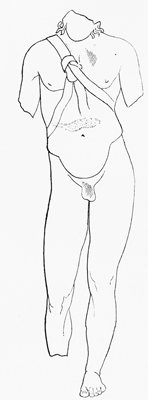 Once, when it was my good fortune to hear Allegri’s “Miserere” sung in the Sistine Chapel at Rome, on a Good-Friday, the performance was introduced by an extremely monotonous chant, which seemed to last for hours, thought possibly for less than one hour. But when, at last, the chant glided into the grand chords of the “Miserere,” the effect of the contrast between the two was so thrilling that one could imagine that of itself it could be enough to make an ordinary composition sound like a strain from a chorus of angels.
Once, when it was my good fortune to hear Allegri’s “Miserere” sung in the Sistine Chapel at Rome, on a Good-Friday, the performance was introduced by an extremely monotonous chant, which seemed to last for hours, thought possibly for less than one hour. But when, at last, the chant glided into the grand chords of the “Miserere,” the effect of the contrast between the two was so thrilling that one could imagine that of itself it could be enough to make an ordinary composition sound like a strain from a chorus of angels.
The same principle is not less operative in the arts that are seen. It explains why folds of drapery, or the straight lines of a girdle band, niche, porch, or pedestal increase, as we must often have remarked, the effectiveness of a human figure in connection with which they are depicted. Observe, in the principal form in Gerome's “Pollice Verso,” Fig.
[click here to enlarge image]
Fig. 7 – Statue of Eros in British Museum
(See pages 31, 186, 289.)
[The Genesis of Art-Form by G.L. Raymond, chapter II, page 030]
26, p. 81, the contrast between the bare flesh and the helmet and other mailing; also how much, even as represented here in outline, the slight band over the shoulder of the “Eros” of the British Museum, Fig. 7, page 30 adds to the general charm of the whole. Notice, too, how much would be lacking to the effect of Claude's “Evening,” Fig. 40, page 119, as well as of Turner's “Decline of Carthage,” Fig. 51, page 175, did either not contain the comparatively few figures of people in the foreground. For the same reason, shrubbery, trees, amid mountain
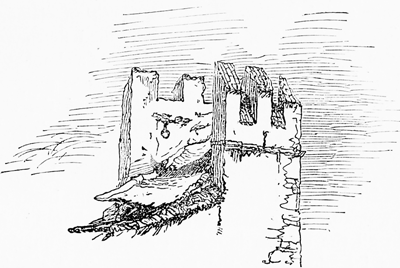 [click here to enlarge image]
[click here to enlarge image]
Fig. 8 scenery augment the attractiveness of houses or towers by which we find them surrounded. See the “Montigny Chateau in the Valley,” Fig. 72, page 221. As applied to the forms of architecture considered in themselves, too, the same is true. Notice the round face of the clock in the chateau just mentioned. Ruskin, in his “Elements of Drawing,” Letter II., illustrates a similar effect by drawing a small iron ring, not corresponding to anything about it, against one wall of a square and angular set of battlements (Fig. 8) and says with reference to the sketch: “All
See page 31.
[The Genesis of Art-Form by G.L. Raymond, chapter II, page 031]
would have been unsatisfactory if there had not happened to be that iron ring on the inner wall, which by its vigorous black circular line precisely opposes all the square and regular characters of the battlements and roof”; and draws the inference that “It is quite singular how very little contrast will sometimes serve to make an entire group of forms interesting, which would otherwise have been valueless.”
In a similar way, a single ray of light, bursting through the clouds of a storm-piece, often both heightens the effect of gloom and introduces into the whole an element of cheerfulness. So, too, with a bright-hued flower, amid the green of a forest, and a bit of gilding on a cloud against the blue of the sky. They answer the same purpose as the round ring amid the angular forms of the sketch drawn by Ruskin. The whole of Jules Breton's picture at one time in the
We pass on to consider the methods of classification that are traceable to the influences of mind and nature combined, or, as we may say now, of unity and variety. Here we need not dwell long. Any class composed of both like and unlike factors necessarily has complexity. So has any single form of art or of nature. These statements need no proof.
Again, if so far as factors are alike they involve com-
[The Genesis of Art-Form by G.L. Raymond, chapter II, page 032]
parison, and so far as they are unlike they involve contrast, it follows that, so far as they are both like and unlike, and yet must both appear to be parts of the same unity, whether of a class or a form, they must involve what we term complement. Two things are complements when they contrast, and yet, as they appear together, complete the one thing to which they equally belong. They must be regarded, too, in classification, because every department of nature is full of them. Certain kinds of metals and ores, leaves amid branches, males and females, alike in some regards, unlike in others, are always found together, and are both necessary to the realization of the type. So in the arts. In those of sound, high and low tones contrast; and yet, if we are to have rhythm, melody, or harmony, both are necessary. In the arts of sight, light amid shade contrast; and yet, if we are to represent the effects of forms as they appear in sunlight, both are necessary. In colors, again, certain hues, like red and blue-green, contrast; and yet as both, when blended together, make white, both may be said to be necessary to the completeness of light. In all these cases the contrasting factors are termed complements. The principle which underlies their use is closely related, both in reality and in ordinary conception, to the developments of it in counteraction and balance. For this reason there is no necessity of illustrating it until we come to treat of them. Enough has been done for our present purpose in merely indicating the fact of its existence, and its influence in producing effects of unity, notwithstanding the presence of contrast
[The Genesis of Art-Form by G.L. Raymond, chapter II, page 033]